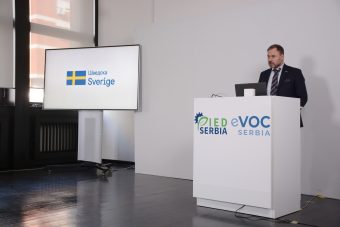
Through project “Further Implementation of the Industrial Emissions Directive – IED Serbia”, implemented over the past three years, Sweden has supported our country both at institutional and individual companies level, with the aim of prompting our European Union accession process. When it comes to the Ministry of Environmental Protection, this project included the support in preparing the legal framework and a part of the Negotiation Position for Chapter 27, which pertains to specific chapters of the Industrial Emissions Directive.
A Directive Specific Implementation Plan has been drafted, describing the measures necessary for full transposition of the Industrial Emissions Directive at the institutional level and at the level of each individual industrial installation. Preparation of this document took place for more than a year, and the analysis included 227 large industrial installations that are subject to the integrated permitting procedure.
Ola Andersson, Head of the Development Cooperation to the Embassy of Sweden, says that the analysis has been conducted regarding the main amendments in legislation on integrated pollution prevention and control, introduced by the Industrial Emissions Directive, referring to certain industrial sectors such as chemical and wood processing industry or waste management.
“These amendments envisage that the obligation to obtain an integrated permit now applies also to additional industrial activities in these sectors and installations of certain capacities in the same sectors. That means that around 75 new operators could be listed as IPPC installations following the adoption of the amended Law and full alignment of the list of activities and installations obligated to obtain an integrated permit with the Annex I to the Industrial Emissions Directive”, Mr Ola Andresson has explained.
In focus:
Specific attention has been paid to the improvement of the environmental inspectors’ knowledge and skills to facilitate their coping with future challenges resulting from the implementation of the Industrial Emissions Directive.
“Electronic tools for the assessment of compliance with Best Available Techniques (BAT) have been developed for three new sectors of the Directive, which include the majority of companies in Serbia that will also fall under the scope of the Directive following the full transposition thereof”, added Mr Andresson.
When it comes to BAT, they have the best environmental performance, efficiently using energy and raw materials, and the practice has already proved their technical feasibility and economic viability. Most companies running businesses in Serbia have sufficient technical knowledge to apply all necessary techniques. The Ministry’s official list comprises 227 installations in Serbia that are subject to the Law on Integrated Pollution Prevention and Control. These industrial installations will have to obtain integrated permits that will contain the programme of compliance with Best Available Techniques.
They will have enough time for that, even several years’ periods, but certain installations will need a longer time to comply. However, for each such installation, Serbia will have to negotiate to obtain additional periods. To facilitate those negotiations, one of the activities of this project included drafting a Directive Specific Implementation Plan (DISP). Based on the results of the conducted analysis and compliance with Best Available Techniques (BAT), financial and social analyses, 68 installations have been identified as those that will need additional extended periods.
“During the cooperation with companies and representatives of competent authorities, many problems have been identified that slow down the integrated permitting process. Companies, most commonly, do not have experience in the development of necessary paperwork, do not have employees responsible for environmental affairs, resolved ownership rights and updated or complete technical documentation. A very commonly noticed problem is the absence of usage and water permits”, explained Mr Andersson.
From the aspect of competent authorities, the primary problems include limited administrative capacities and other permitting procedures. All stated problem indicated the need for building and strengthening administrative capacities, especially at the local level. To that end, a part of project activities was focused on providing direct technical assistance both to operators and competent authorities. They comprised delivery of several workshops and meetings with representatives of both sides to share experience and speed up the permitting procedure.
Prepared by: Milica Radičević
Read the whole interview in the new issue of the Energy portal Magazine CIRCULAR ECONOMY, march 2021 – may 2021.



